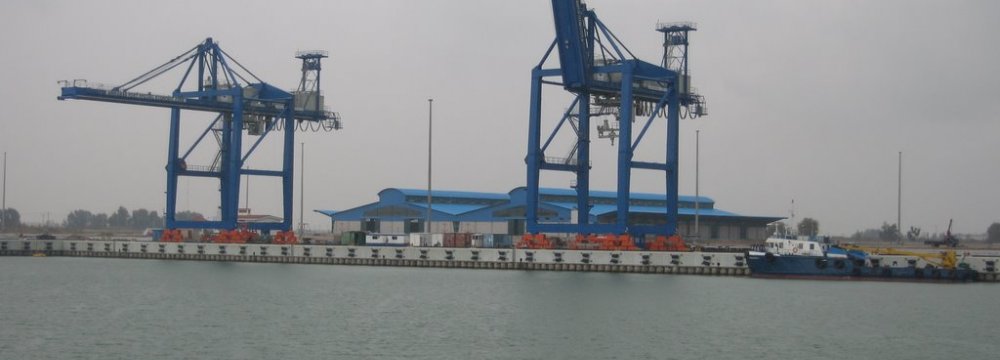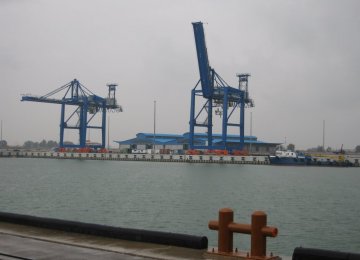As we continue our guide through Iran's special economic zones (SEZs), which are different from their free trade zone cousins (FTZs) with slightly different laws and regulations catering to foreign businesses and differing tax law grace periods, this time we'll focus more on the lesser known SEZs in northern Iran.
In this article we'll mainly focus on the northeastern frontiers, which include Amirabad SEZ on the southeastern shores of the Caspian Sea and Sarakhs, which borders Turkmenistan and is situated along the path of the ancient Silk Road.
Amirabad SEZ
Amirabad is a main stop along the newly proposed and expanding North-South Corridor, which in theory will connect St. Petersburg in the Russian Federation to the southern Chabahar Port in the Persian Gulf – which itself has just been bumped up to full free trade zone status – and onto the Indian sub-continent, Africa, and East Asia.
The profile of Amirabad Port considerably jumped in 1993 when the ministers of several European and Asian countries introduced the newly proposed North-South Corridor as a quicker alternant route for goods moving in both directions. The advantages of this new route would – like previously mentioned in other articles about the economic zones – substantially cut the time and cost of transporting goods, and also speed up bilateral relations between Scandinavian countries and those of Central Asia. Analysts have suggested that the new transportation method, through Central Asia would double the speed between Europe and Asia, and also cut out the Suez Canal from the transport equation – or so it hopes.
Iran Ports and Maritime Organization states that "transportation costs for the transfer of goods between the countries within the Indian Ocean and North Europe zones are 30% cheaper through the North-South Corridor. One of the important advantages of this corridor is the several interchanges it has with different corridors between Central Asia and Europe including Traceca and Altide."
Amirabad is the only northern port which is connected to the national railway system; however other ports are likely to connect soon with more investment coming online. Iran's FTZ and SEZ website states, "Amirabad's numerous advantages include location on the International North-South Transit Corridor, possession of a high number of berths, vast support area (1,000 hectares), and berths accommodating Ro-Ro vessels and trains and trucks that have created a multimodal transportation system. It adds that the modern loading and discharging equipment, vast open and covered storage areas and its use of the information technology has minimized the time the vessels spend at port, and created a secure place for storing different goods including food products and petrochemical by-products.
Business Deals
Back in February Amirabad's authorities released a PR piece on a group of top CIS state businesspeople – mainly Kazakh – visiting the port area looking for ways to enhance their economic cooperation. The visit came in the wake of the cooperation of the Caspian littoral states agreement on the framework for the future of the body of water in December 2013. The director general of the port, Ali Naimi, said that Amirabad has vast potential for foreign investment and added that the security of the investment and security as well as the standards of the port equipment is guaranteed in Amirabad. Referring to the port's performance in terms of cargo loading and discharge, Amirabad’s director general said that Kazakhstan is among the ports with the highest relation with the port.
Although news about Amirabad is fleeting at best, the occasional piece of news is available for reading on their website and through trade panels online, mainly based in ports in the north of the country. Blackseagrain.net – a major commodities portal for countries surrounding the two northern seas – said in October that Iran continues to be a major buyer of Kazakh grain. It is generally known that Kazakhstan has opened its own grain terminal in Amirabad. This allows exporting an additional 500 KMT of Kazakh grain through this segment of the corridor. The construction of the grain terminal in Iran was the final link of a logistics and transport chain for exporting Kazakh grain to the markets of Iran and Transcaucasia.
The website also stated that grain exports to Iran totaled 221,000 metric tonnes in Q1 2014, up 20% from the same period last year, the majority of which was transported through the Amirabad port.
The port sees itself as the main conduit between Iran and the north and thus has had the backing from the government in Tehran to develop the area around it. So far it is still classed as SEZ; however, in recent months the Rouhani administration has made explicit gestures about its goals for the SEZ community around the country. It plans to increase the amount of SEZs in different cities and regions and is likely to upgrade the best performing ones into fully fledged FTZs.
> Sarakhs SEZ
Our second northern SEZ is the Sarakhs zone. This, unlike the one discussed above, borders a neighboring country. In recent years this zone has had the special situation of being the main transit point for goods going to and coming from Turkmenistan and further to countries in Central Asia. It also plays an important role in terms of its railway, which historically and before the fall of the Soviet Union was one of the main transit points between the two nations.
The zone is situated 150 km east of Mashhad, Iran's second largest city and is 15 km from the city of Sarakhs and its counterpart city Serakhs on the Turkmenistan side of the border.
With an area of 5,290 hectares, the Sarakhs zone is located in northeastern Iran and connects ports in the Gulf of Oman and the Persian Gulf to Central Asia, the Caucasus and Russia through the national road and rail network.
Sarakhs was recently mentioned in a news report by Fars new agency, which stated that the head of the Trade and Promotion Organization, Valiollah Afkhami-rad announced the SEZ is now open for foreign investment. "The zone is ready to accept and cooperate with foreign investors who are willing to take part in economic and industrial activities there."
During the first half of the current year (March 21-September 22), 6,982 tons of products including construction materials, tea, nuts and chocolates were produced in companies stationed in Sarakhs SEZ, showing an increase of 217% compared to the same period last year.
This jump in production does show signs that the economic zone is performing well, and is contributing to the overall improvement in the economic outlook.
On November 7, another report came out from the same news agency, suggesting that new ports will connect to the SEZ. It stated that the Indian Shipping Minister Nitin Gadkari had stressed that his country is resolved to make major investments in the southern Iranian port of Chabahar, which connects to Sarakhs, in various sectors. In July, the head of Iran's Chamber of Commerce, Industries, Mines and Agriculture (ICCIMA) Gholam Hossein Shafei pointed to Iran's development plan for the national rail system, saying that the government "plans to connect Mashhad rail road in northeastern Iran to the western Afghan province of Herat and will soon launch development projects in Sarakhs Special Economic Zone."





